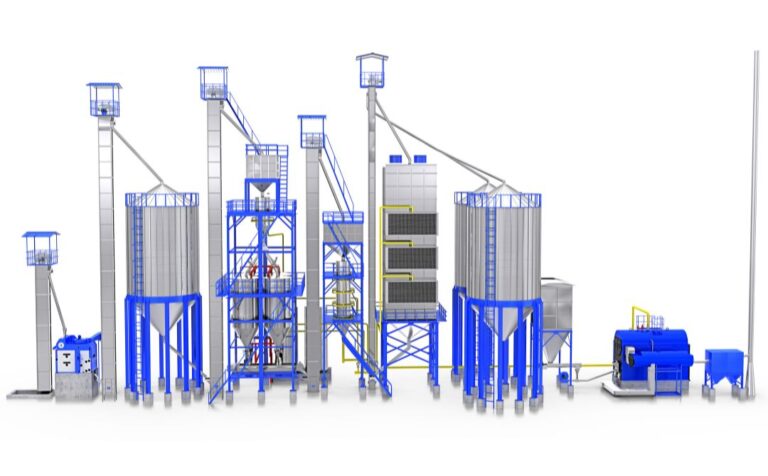Table of Contents
Rice is a cornerstone of Indian cuisine, feeding millions and anchoring agricultural economies across the nation. With over 120 million tonnes of paddy produced annually, the processing method, whether parboiling or milling directly into raw rice, plays a pivotal role in determining its nutritional profile and health benefits.
At SKF Elixer, we enhance rice quality through our advanced paddy processing plants, specializing in parboiling systems that maximize the natural value of parboiled rice. Our technology ensures rice manufacturers deliver nutrient-rich products to meet the growing demand for healthier food choices in India.
This blog explores the nutritional benefits of parboiled rice compared to raw rice, highlighting how parboiling enhances health outcomes and why SKF Elixer’s solutions are ideal for producing high-quality parboiled rice.
Whether you’re a rice miller in West Bengal, a cooperative leader in Tamil Nadu, or a health-conscious consumer in Delhi, our insights will guide you toward informed choices for better nutrition.
The Importance of Rice Nutrition in India
Rice is a dietary staple for over 70% of India’s population, contributing significantly to daily caloric and nutrient intake. However, the nutritional content of rice varies based on processing. Raw rice, often milled directly from paddy, loses nutrients during polishing, while parboiled rice retains more vitamins and minerals due to its hydrothermal treatment.
With rising health concerns like diabetes and malnutrition affecting 77 million and 190 million Indians respectively, choosing nutrient-dense rice is critical. A family consuming 10 kilograms of rice monthly can improve health outcomes by opting for parboiled rice, potentially reducing healthcare costs by ₹2,000–₹5,000 annually through better nutrition.
SKF Elixer’s parboiling plants, using hot water soaking and automated drying, produce parboiled rice that retains 20–30% more nutrients than raw rice, aligning with India’s push for healthier diets under initiatives like Poshan Abhiyaan.
What Is Parboiled Rice?
Parboiling involves soaking paddy in hot water (70–85°C), tempering, and drying before milling, which gelatinizes the starch and drives nutrients from the bran into the endosperm. This results in parboiled rice with a translucent, amber appearance, firmer texture, and enhanced nutritional value.
Raw rice, conversely, is milled directly from dried paddy, losing much of its bran and nutrient content during polishing.
SKF Elixer’s parboiling plants optimize this process, handling 5–50 tonnes per day with energy-efficient systems, ensuring rice manufacturers produce high-quality parboiled rice with minimal nutrient loss. Read more on the process of paddy processing.
Nutritional Benefits of Parboiled Rice Compared to Raw Rice
Parboiled rice offers distinct nutritional advantages over raw rice, making it a healthier choice for families and communities. Below, we compare key nutritional aspects:
1. Difference in Vitamins and Minerals
- Parboiled Rice: The parboiling process retains 80–90% of vitamins and minerals from the bran. A 100-gram serving contains 0.4–0.6 mg thiamine (vitamin B1, 30–50% of daily needs), 2–3 mg iron (10–15% of daily needs), and 20–30 mg magnesium. These support energy metabolism, red blood cell production, and muscle health.
- Raw Rice: Polishing removes 70–80% of bran nutrients, leaving 0.1–0.2 mg thiamine, 0.5–1 mg iron, and 10–15 mg magnesium per 100 grams, significantly reducing nutritional value.
For a family consuming 10 kilograms monthly, parboiled rice provides 20–30% more B vitamins, reducing deficiency risks and healthcare costs by ₹2,000–₹5,000 annually.
2. Rice Protein Content
- Parboiled Rice: Retains 7–8 grams of protein per 100 grams due to nutrient migration during parboiling, supporting muscle growth and immune health.
- Raw Rice: Contains 6–7 grams of protein per 100 grams, slightly lower due to bran loss during milling.
This 1-gram difference per 100 grams translates to 100–150 grams more protein monthly for a family, aiding child growth and reducing malnutrition risks.
3. Parboiled Rice Calories
- Parboiled Rice: Provides 350–360 kcal per 100 grams, slightly lower than raw rice due to starch gelatinization, which enhances digestibility and reduces glycemic load.
- Raw Rice: Offers 360–370 kcal per 100 grams, with a higher glycemic index (70–89 vs. 38–50 for parboiled), making it less suitable for blood sugar management.
For individuals managing diabetes, parboiled rice’s lower glycemic index reduces blood sugar spikes, potentially saving ₹3,000–₹5,000 annually in medical costs.
4. Parboiled Rice vs. Raw Rice for Weight Loss
Parboiled rice’s lower glycemic index and higher fiber content (1–1.5 grams per 100 grams vs. 0.4–0.6 grams for raw rice) promote satiety, aiding weight management. A 100-gram serving of parboiled rice keeps you fuller longer, reducing snacking and supporting weight loss goals, unlike raw rice, which may cause quicker hunger pangs.
5. Natural Value of Parboiled Rice
Parboiled rice retains antioxidants like ferulic acid (20–30% higher than raw rice), which combat oxidative stress, reducing chronic disease risks. This makes it a natural choice for health-conscious consumers, increasing market value by ₹5–10 per kilogram.
Is Parboiled Rice Better for Health Than Raw Rice?
Parboiled rice is generally healthier due to:
- Higher Nutrient Retention: 20–30% more vitamins and minerals, supporting immunity and metabolism.
- Lower Glycemic Index: Reduces diabetes risk, saving ₹3,000–₹5,000 annually in healthcare for a family.
- Improved Digestibility: Gelatinized starch enhances nutrient absorption, benefiting children and the elderly.
- Pest Resistance: Extends shelf life by 6–12 months, reducing storage losses by ₹10,000–₹20,000 per 10 tonnes.
Disadvantages of Consuming Non-parboiled Rice
Raw rice, while widely consumed, has drawbacks:
- Nutrient Loss: Polishing removes 70–80% of vitamins and minerals, increasing deficiency risks.
- Higher Glycemic Index: Spikes blood sugar, unsuitable for diabetics, costing ₹3,000–₹5,000 annually in medical expenses.
- Lower Milling Yield: Breakage during milling (3–5%) reduces output by 300–500 kilograms per 10 tonnes, worth ₹15,000–₹25,000.
- Shorter Shelf Life: Susceptible to weevils, causing 2–3% storage losses (₹10,000–₹15,000 per 10 tonnes).
How SKF Elixer’s Parboiling Plants Enhance Nutrition
SKF Elixer’s paddy parboiling plants optimize nutrient retention:
- Hot Water Soaking: Controlled at 70–85°C for 1–3 hours, retains 80–90% of thiamine and minerals, unlike traditional methods losing 30–40%.
- Automated Drying: Reduces moisture to 12–14% in 6–8 hours, preventing nutrient leaching and saving ₹20,000–₹30,000 per 10-tonne batch in losses.
- Monitoring: Ensures precise temperature and moisture control, improving gelatinization by 20%, enhancing nutritional quality.
Our plants, handling 5–50 tonnes per day, produce parboiled rice that meets FSSAI standards, adding ₹5–10 per kilogram in market value.
Why Choose SKF Elixer?
With years of expertise, SKF Elixer delivers BIS-certified parboiling plants tailored for India’s rice varieties. Our options, support, and AMCs ensure reliability and affordability for rice manufacturers nationwide.
Conclusion
Parboiled rice offers superior nutritional benefits over raw rice, with higher vitamins, minerals, and better health outcomes. SKF Elixer’s advanced parboiling plants enhance these benefits, delivering high-quality rice that supports India’s health and economy. Choose our solutions to produce nutrient-rich rice and meet growing market demand.
Ready to enhance your rice production? Contact SKF Elixer to explore our tailored parboiling plants.
FAQs
-
1. What are the nutritional benefits of parboiled rice compared to raw rice?
Parboiled rice retains 20–30% more thiamine (0.4–0.6 mg/100g), iron (2–3 mg), and magnesium (20–30 mg), supporting energy and immunity. It saves ₹2,000–₹5,000 annually in healthcare for a family consuming 10 kg monthly.
-
2. Is parboiled rice better for health than raw rice?
Yes, parboiled rice has a lower glycemic index (38–50 vs. 70–89), higher fiber (1–1.5 g/100g), and better nutrient retention, reducing diabetes risks and saving ₹3,000–₹5,000 annually in medical costs.
-
3. What is the difference in vitamins and minerals in parboiled rice vs. raw rice?
Parboiled rice contains 0.4–0.6 mg thiamine, 2–3 mg iron, and 20–30 mg magnesium per 100g, compared to 0.1–0.2 mg, 0.5–1 mg, and 10–15 mg for raw rice, offering 20–30% more nutrients.
-
4. Which rice is healthier, parboiled or raw?
Parboiled rice is healthier due to higher nutrient retention, lower glycemic index, and better digestibility, preventing deficiencies and supporting weight management, saving ₹2,000–₹5,000 annually for families.
-
5. How does parboiled rice vs. raw rice aid weight loss?
Parboiled rice’s lower glycemic index (38–50) and higher fiber (1–1.5 g/100g) promote satiety, reducing snacking compared to raw rice (0.4–0.6 g fiber), supporting weight loss and better health outcomes.
Good reads are meant to be shared









